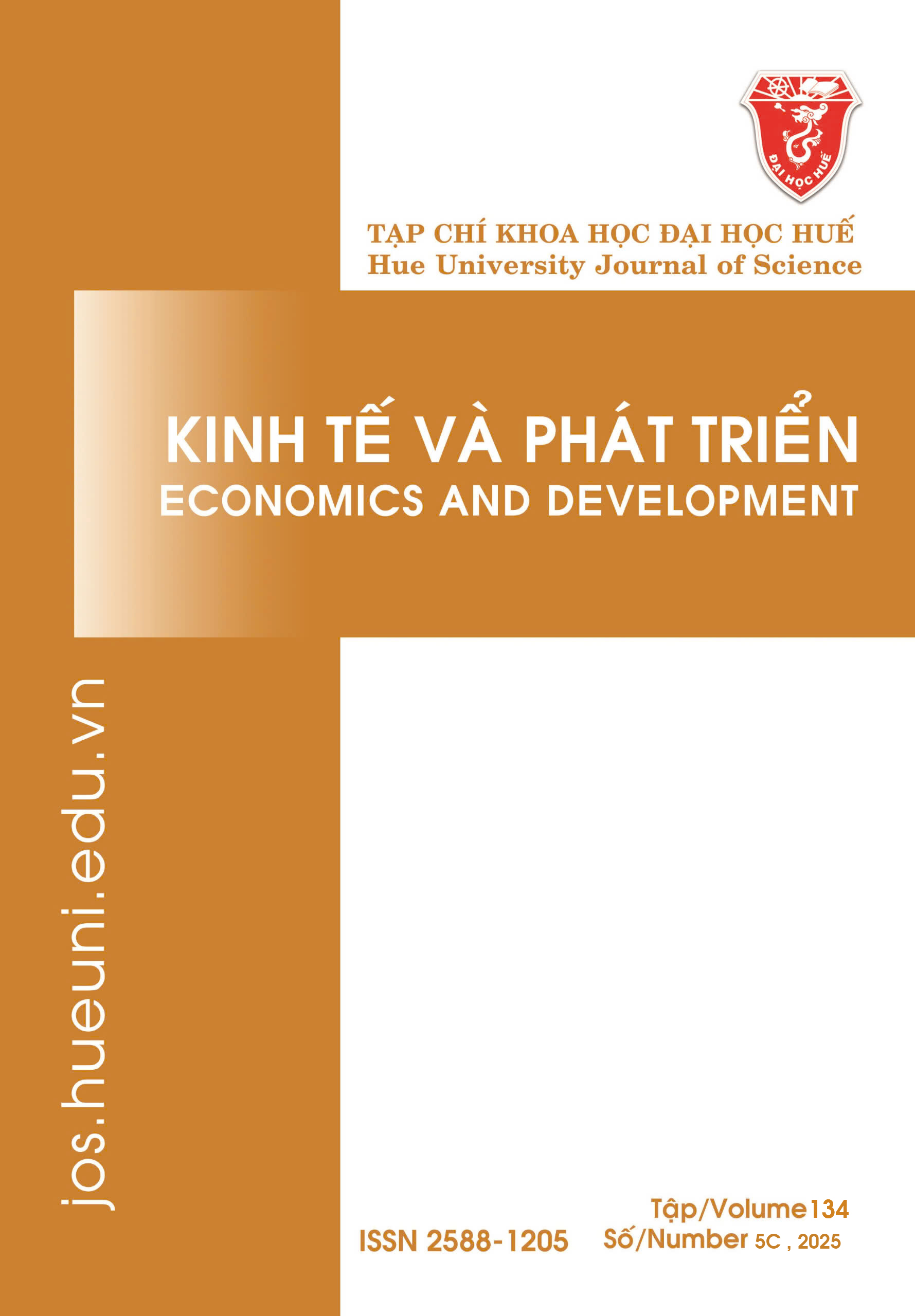Abstract
This study investigates the impact of 3R practices (Reduce – Reuse – Recycle) on the sustainable performance of F&B enterprises in Hue City, within the broader context of promoting a circular economy. Data were collected from 220 businesses across three main F&B service types and analyzed using Confirmatory Factor Analysis (CFA) and Structural Equation Modeling (SEM). The results reveal that 3R practices significantly and positively influence all three pillars of sustainability: economic performance, environmental impact, and social contribution. Among them, the environmental dimension is the most strongly affected, followed by social and economic aspects. These findings reinforce the idea that 3R practices not only enhance environmental protection but also serve as strategic tools for improving operational efficiency and brand reputation. Based on the results, the study proposes key policy implications, including financial incentives, targeted training programs, upgraded recycling infrastructure, and standardized assessment frameworks to measure 3R effectiveness in enterprises.
References
- K. Capital (2024), Báo cáo ngành Food & Beverage Việt Nam.
- FAO (2011), Global Food losses and Food waste, [Online]. Available: http://www.unep.org/wed/2013/ quickfacts.
- J. D. azimi Jibril, I. Bin Sipan, M. Sapri, S. A. Shika, M. Isa, and S. Abdullah (2012), 3Rs Critical Success Factor in Solid Waste Management System for Higher Educational Institutions, Procedia - Social and Behavioral Sciences, 65, ICIBSoS, 626–631, doi: 10.1016/j.sbspro.2012.11.175.
- M. Immanuel, R. Hartopo, S. P. Anantadjaya, and T. Saroso (2013), Food Waste Management: 3R Approach in Selected Family-Owned Restaurants, 02, 01, [Online]. Available: http://papers.ssrn.com/abstract=2280928.
- M. Ahmadi (2017), Evaluating the Performance of 3Rs Waste Practices: Case Study-Region One Municipality of Tehran, Advances in Recycling and Waste Management, 02, 02, doi: 10.4172/2475-7675.1000130.
- E. Papargyropoulou, R. Lozano, J. K. Steinberger, N. Wright, and Z. Bin Ujang (2014), The food waste hierarchy as a framework for the management of food surplus and food waste, Journal of Cleaner Production, 76, 106–115, doi: 10.1016/j.jclepro.2014.04.020.
- M. E. Pratarelli and G. Mainguy (2010), Surveys and Perspectives Integrating Environment and Society Social Pressure and Recycling: A Brief Review, Commentary and Extensions, OpenEdition Journals, 03, 01, 1–10.
- G. Allen (2020), “The 3Rs: Reduce, Reuse, Recycle,” https://www.fmtn.org/Blog.aspx?IID=21.
- N. Haluzan (2009), How Does Global Warming Affect Animals?.
- M. J. Epstein and M. J. Roy (2024), Making the business case for sustainability: Linking social and environmental actions to financial performance, J. Corp. Citizsh., 09, 79–96, doi: 10.9774/gleaf.4700.2011.su.00008.
- T. Katz-Gerro and J. López Sintas (2019), Mapping circular economy activities in the European Union: Patterns of implementation and their correlates in small and medium-sized enterprises, Business Strategy and The Environment, 28, 04, 485–496, doi: https://doi.org/10.1002/bse.2259.
- S. Harris, M. Martin, and D. Diener (2021), Circularity for circularity’s sake? Scoping review of assessment methods for environmental performance in the circular economy, Sustainable Production and Consumption, 26, 172–186, doi: https://doi.org/10.1016/j.spc.2020.09.018.
- H. N. Nguyen and S. Mohamed (2011), Leadership behaviors, organizational culture and knowledge management practices: An empirical investigation, Journal of Management Development, 30, 02, 206–221, doi: 10.1108/02621711111105786.
- S. Sauvé, S. Bernard, and P. Sloan (2016), Environmental sciences, sustainable development and circular economy: Alternative concepts for trans-disciplinary research, Environmental Development, 17, 48–56, doi: https://doi.org/10.1016/j.envdev.2015.09.002.
- P. K. Dey, C. Malesios, S. Chowdhury, K. Saha, P. Budhwar, and D. De (2022), Adoption of circular economy practices in small and medium-sized enterprises: Evidence from Europe, Internatioal Journal of Production Economics, 248, February, 108496, doi: 10.1016/j.ijpe.2022.108496.
- O. Rodríguez-Espíndola et al.(2022), The role of circular economy principles and sustainable-oriented innovation to enhance social, economic and environmental performance: Evidence from Mexican SMEs, Internatioal Journal of Production Economics, 248, February, 108495, doi: 10.1016/j.ijpe.2022.108495.
- S. Chowdhury et al. (2022), Impact of Organisational Factors on the Circular Economy Practices and Sustainable Performance of Small and Medium-sized Enterprises in Vietnam,” Journal of Business Research, 147, 362–378, doi: 10.1016/j.jbusres.2022.03.077.
- J. F. Hair, R. E. Anderson, R. L. Tatham, and C. William (1998), Black (1998), Multivariate data analysis, Upper Saddle River, NJ: Prentice Hall.
- J. F. Hair (2021), Partial Least Squares Structural Equation Modeling (PLS-SEM) Using R, Classroom Companion: Business.
- B. M. Byrne (2013), Structural equation modeling with Mplus: Basic concepts, applications, and programming, Routledge.
- K. A. Bollen (1989), Structural equations with latent variables., John Wiley & Sons.
- C. Fornell and D. F. Larcker (1981), Structural equation models with unobservable variables and measurement error: Algebra and statistics, Sage publications Sage CA: Los Angeles, CA.
- M.-F. Chen (2016), Extending the theory of planned behavior model to explain people’s energy savings and carbon reduction behavioral intentions to mitigate climate change in Taiwan–moral obligation matters, Journal of Cleaner Production, 112, 1746–1753.
- B. Zhang, S. Yang and J. Bi (2013), Enterprises’ willingness to adopt/develop cleaner production technologies: an empirical study in Changshu, China, Journal of Cleaner Production, 40, 62–70, doi: https://doi.org/10.1016/j.jclepro.2010.12.009.
- D. Hooper, J. Coughlan, and M. R. Mullen (2008), Structural Equation Modelling: Guidelines for Determining Model Fit, Electron. J. Bus. Res. Methods, 06, 01, 53–60.
- P. M. Bentler (1990), Comparative fit indexes in structural models, Psychological Bulletin, 107, 02, 238–246.
- M. W. Browne and R. Cudeck (1993), Alternative ways of assessing model fit, Testing Structural Equation Models, K. A. Boll., 136–162.
- Y. Cai et al. (2023), Enhancing SWAT model with modified method to improve Eco-hydrological simulation in arid region, Journal of Cleaner Production, 403, 136891, doi: https://doi.org/10.1016/j.jclepro.2023.136891.

This work is licensed under a Creative Commons Attribution-ShareAlike 4.0 International License.
Copyright (c) 2025 Array
